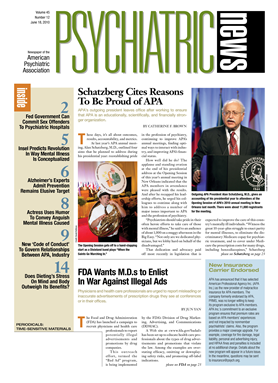Mental illnesses may share common genetic mutations, differentiated into varying clinical presentations and symptoms—now categorized as distinct diagnoses—by all manner of environmental influences affecting multiple brain circuits and ultimately human behavior.
That's the picture that is emerging from cutting-edge research in the last two years, a picture that is certain to transform the way clinicians and researchers regard mental illness in the future, said National Institute of Mental Health Director Thomas Insel, M.D.
In a media briefing last month introducing the May 19 mental health theme issue of the Journal of the American Medical Association (JAMA), Insel called for a “revolution” in the way mental illness is conceptualized.
In that JAMA issue, Insel wrote a commentary titled “Rethinking Mental Illness,” in which he said that “[g]enetics and neuroscience finally have the tools to transform the diagnosis and treatment of mental illness. But first, it is time to rethink mental disorders, recognizing that these are disorders of brain circuits likely caused by developmental processes shaped by a complex interplay of genetics and experience.”
The
JAMA theme issue includes six research papers and four commentaries, including one by Darrel Regier, M.D., M.P.H., head of APA's Division of Research, and David Kupfer, M.D., chair of the
DSM-5 Task Force. The commentary by Regier and Kupfer focused on “Why All of Medicine Should Care About
DSM-5” (see
JAMA Explores DSM-5). The
JAMA issue also includes an article on Vincent van Gogh's treatment for mental illness; on the cover of the journal is van Gogh's painting “Courtyard of the Hospital at Arles,” depicting the hospital where he was treated in 1889, the year before his death.
Speaking to reporters at the briefing, Insel said that current diagnostic categories based on how people present to the clinician—self-reported symptoms and clinical judgment of appearance and behavior—must at some time give way to the new findings based on genetics and neuroscience.
“We have been locked into a diagnostic structure based on how people present,” Insel said. “We did that 100 years ago in cardiology and infectious disease. There is a value in that, but most of medicine has gone way beyond that.”
Where the rest of medicine has gone, and where research and treatment of mental illness must go, is in the direction of genetic and biological markers of disease. Insel said that what is emerging today is a picture of mental illness as the result of a pathophysiological chain from genes to cells to distributive systems within the brain, based on a patient's unique genetic variation.
“In the case of people with schizophrenia or autism or bipolar disorder or ADHD, we are beginning to find lots of rare but highly [potent] lesions in the genome,” he said. “Unlike what we see for common medical illnesses, in the case of mental illness we are looking at many, many different genetic contributors, so rare they are called ‘private mutations.’
“Even more surprising is the fact that these very rare mutations appear not to be associated with any single illness,” Insel said. “Rather, the same genetic lesion may be associated with different disorders.”
For any individual, the private mutation may take a different developmental pathway that affects multiple complex brain circuits, resulting in the anomalous thoughts, feelings, and behaviors that have been categorized in today's diagnostic system.
Incorporating these cutting-edge research findings into clinical practice will ultimately result in a new paradigm for treatment. In the case of psychosis, for instance, Insel said they will pave the way for much earlier intervention.
“Psychosis is a very late stage in the developmental process, in the same way that a myocardial infarction is a late-stage symptom of cardiovascular disease,” he said. “The real ‘bang for the buck’ in cardiovascular medicine is getting much earlier identification of people with high cholesterol and intervening at that stage to prevent a heart attack.
“That is what we would like to do with schizophrenia, but today all the effort goes into very-late-stage treatment of psychosis during the phase of chronic illness. Ultimately we need to begin identifying patients not only when they start to lose function but even prior to that, when they are still presymptomatic and have only the risk factors for psychosis.”

